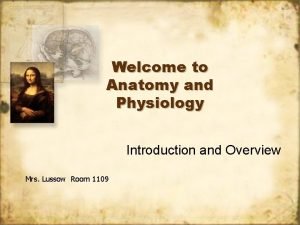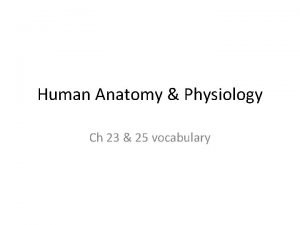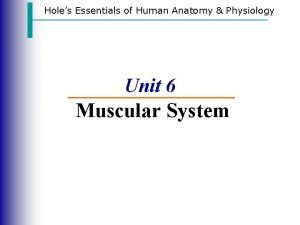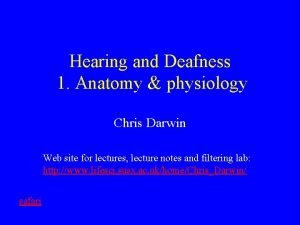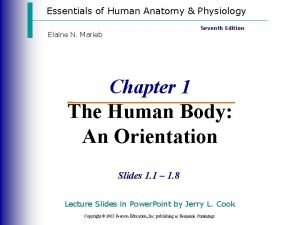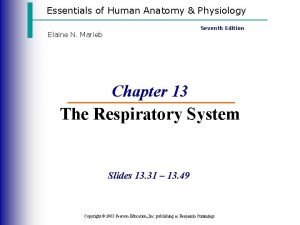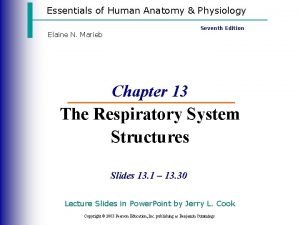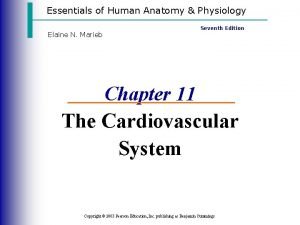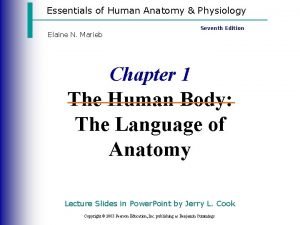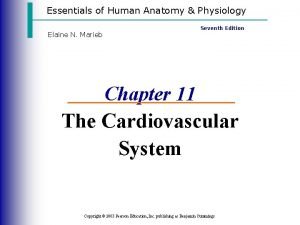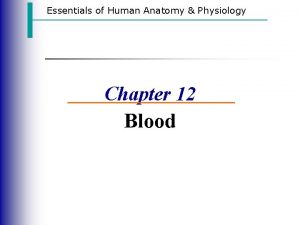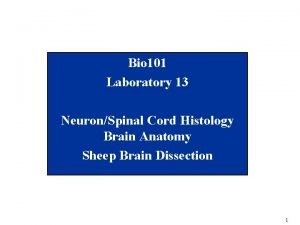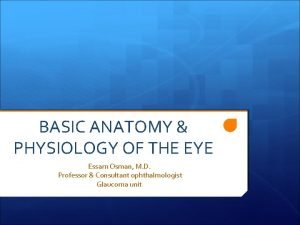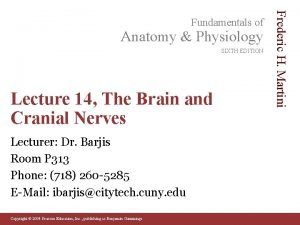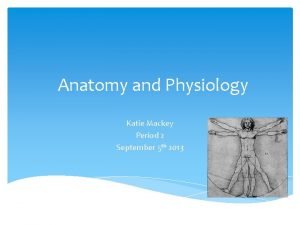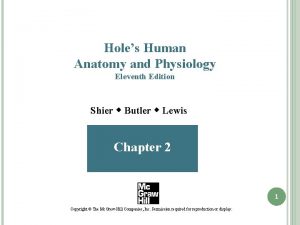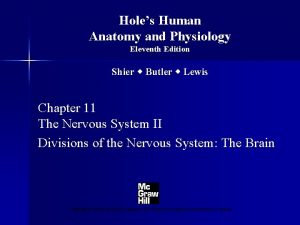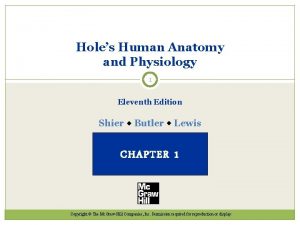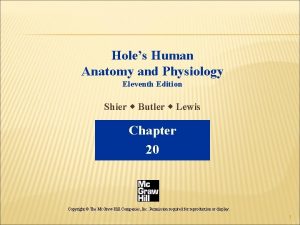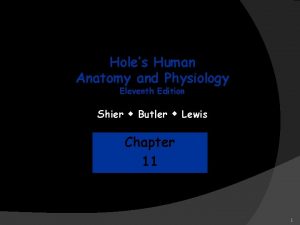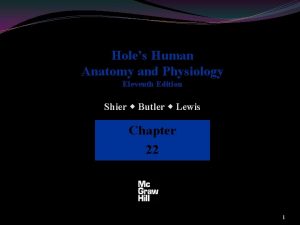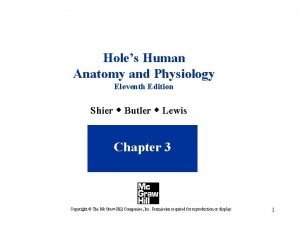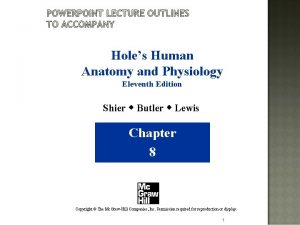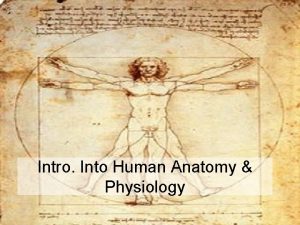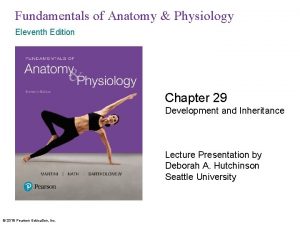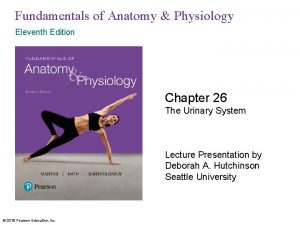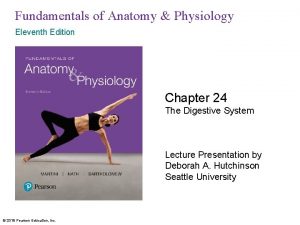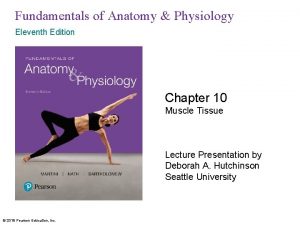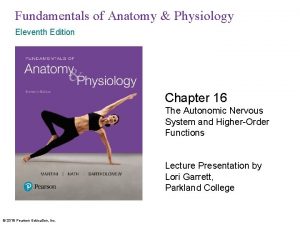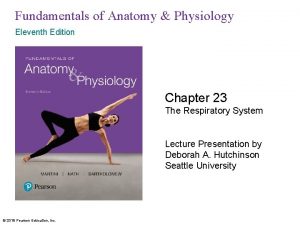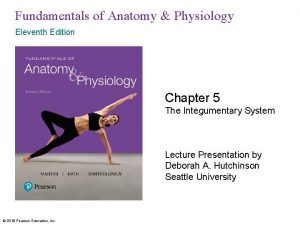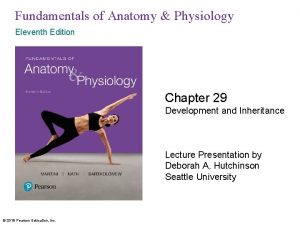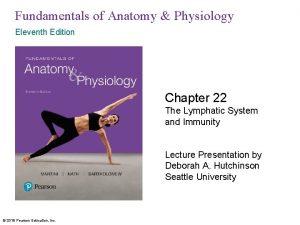Human Anatomy and Physiology Eleventh Edition Chapter 22

















































































- Slides: 81

Human Anatomy and Physiology Eleventh Edition Chapter 22 Part B The Respiratory System Power. Point® Lectures Slides prepared by Karen Dunbar Kareiva, Ivy Tech Community College Copyright © 2019, 2016, 2013 Pearson Education, Inc. All Rights Reserved

PART 2 –RESPIRATORY PHYSIOLOGY Copyright © 2019, 2016, 2013 Pearson Education, Inc. All Rights Reserved

22. 4 Mechanics of Breathing • Pulmonary ventilation consists of two phases – Inspiration: gases flow into lungs – Expiration: gases exit lungs Copyright © 2019, 2016, 2013 Pearson Education, Inc. All Rights Reserved

Pressure Relationships in the Thoracic Cavity (1 of 6) • Atmospheric pressure (Patm) – Pressure exerted by air surrounding the body – 760 mm Hg at sea level = 1 atmosphere • Respiratory pressures described relative to Patm – Negative respiratory pressure: less than Patm – Positive respiratory pressure: greater than Patm – Zero respiratory pressure: equal to Patm Copyright © 2019, 2016, 2013 Pearson Education, Inc. All Rights Reserved

Pressure Relationships in the Thoracic Cavity (2 of 6) • Intrapulmonary pressure (Ppul) – Pressure in alveoli § Also called intra-alveolar pressure – Fluctuates with breathing – Always eventually equalizes with Patm Copyright © 2019, 2016, 2013 Pearson Education, Inc. All Rights Reserved

Pressure Relationships in the Thoracic Cavity (3 of 6) • Intrapleural pressure (Pip) – Pressure in pleural cavity – Fluctuates with breathing – Always a negative pressure (<Patm and <Ppul) § Usually always 4 mm Hg less than Ppul – Fluid level must be kept at a minimum § Excess fluid pumped out by lymphatic system § If fluid accumulates, positive Pip pressure develops – Lung collapses Copyright © 2019, 2016, 2013 Pearson Education, Inc. All Rights Reserved

Pressure Relationships in the Thoracic Cavity (4 of 6) • Intrapleural pressure (Pip) (cont. ) – Two inward forces promote lung collapse 1. Lungs’ natural tendency to recoil – Because of elasticity, lungs always try to assume smallest size 2. Surface tension of alveolar fluid – Surface tension pulls on alveoli to try to reduce alveolar size Copyright © 2019, 2016, 2013 Pearson Education, Inc. All Rights Reserved

Pressure Relationships in the Thoracic Cavity (5 of 6) • Intrapleural pressure (Pip) (cont. ) – One outward force tends to enlarge lungs § Elasticity of chest wall pulls thorax outward – Negative Pip is affected by these opposing forces but is maintained by strong adhesive force between parietal and visceral pleurae Copyright © 2019, 2016, 2013 Pearson Education, Inc. All Rights Reserved

Pressure Relationships in the Thoracic Cavity (6 of 6) • Transpulmonary pressure – Transpulmonary pressure = (Ppul Pip) § Pressure that keeps lung spaces open – Keeps lungs from collapsing § Greater transpulmonary pressure, the larger the lungs will be – Lungs will collapse if: § Pip = Ppul or § Pip = Patm § Negative Pip must be maintained to keep lungs inflated Copyright © 2019, 2016, 2013 Pearson Education, Inc. All Rights Reserved

Intrapulmonary and Intrapleural Pressure Relationships Figure 22. 14 Intrapulmonary and intrapleural pressure relationships. Copyright © 2019, 2016, 2013 Pearson Education, Inc. All Rights Reserved

Pneumothorax Figure 22. 15 Pneumothorax. Copyright © 2019, 2016, 2013 Pearson Education, Inc. All Rights Reserved

Clinical – Homeostatic Imbalance 22. 7 • Atelectasis: lung collapse due to – Plugged bronchioles, which cause collapse of alveoli, or – Pneumothorax, air in pleural cavity § Can occur from either wound in parietal pleura or rupture of visceral pleura § Treated by removing air with chest tubes § When pleurae heal, lung reinflates Copyright © 2019, 2016, 2013 Pearson Education, Inc. All Rights Reserved

Pulmonary Ventilation (1 of 7) • Consists of inspiration and expiration • Mechanical process that depends on volume changes in thoracic cavity – Volume changes lead to pressure changes – Pressure changes lead to flow of gases to equalize pressure Copyright © 2019, 2016, 2013 Pearson Education, Inc. All Rights Reserved

Pulmonary Ventilation (2 of 7) • Boyle’s law: relationship between pressure and volume of a gas – Gases always fill the container they are in § If amount of gas is the same and container size is reduced, pressure will increase – So pressure (P) varies inversely with volume (V) – Mathematically: § P 1 V 1 = P 2 V 2 Copyright © 2019, 2016, 2013 Pearson Education, Inc. All Rights Reserved

Pulmonary Ventilation (3 of 7) • Inspiration – Active process involving inspiratory muscles (diaphragm and external intercostals) § Action of the diaphragm: when dome-shaped diaphragm contracts, it moves inferiorly and flattens out – Results in increase in thoracic volume § Action of intercostal muscles: when external intercostals contract, rib cage is lifted up and out, much like when handle on a bucket is raised (outward as it moves upward) – Results in increase in thoracic volume Copyright © 2019, 2016, 2013 Pearson Education, Inc. All Rights Reserved

Changes in Thoracic Volume and Sequence of Events During Inspiration and Expiration Figure 22. 16 Changes in thoracic volume and sequence of events during inspiration and expiration. Copyright © 2019, 2016, 2013 Pearson Education, Inc. All Rights Reserved

Pulmonary Ventilation (4 of 7) • Inspiration (cont. ) – As thoracic cavity volume increases, lungs are stretched as they are pulled out with thoracic cage § Causes intrapulmonary pressure to drop by 1 mm Hg Ppul < Patm § Because of difference between atmospheric and intrapulmonary pressure, air flows into lungs, down its pressure gradient, until Ppul = Patm – During same period, Pip lowers to about 6 mm Hg less than Patm Copyright © 2019, 2016, 2013 Pearson Education, Inc. All Rights Reserved

Pulmonary Ventilation (5 of 7) • Inspiration (cont. ) – Forced (deep) inspirations can occur during vigorous exercise or in people with COPD – Accessory muscles are also activated § Scalenes, sternocleidomastoid, and pectoralis minor – Erector spinae muscles of back also help to straighten thoracic curvature § Act to further increase thoracic cage size, creating a larger pressure gradient so more air is drawn in Copyright © 2019, 2016, 2013 Pearson Education, Inc. All Rights Reserved

Changes in Thoracic Volume and Sequence of Events During Inspiration and Expiration (1 of 10) Figure 22. 16 Changes in thoracic volume and sequence of events during inspiration and expiration. Copyright © 2019, 2016, 2013 Pearson Education, Inc. All Rights Reserved

Changes in Thoracic Volume and Sequence of Events During Inspiration and Expiration (2 of 10) Figure 22. 16 Changes in thoracic volume and sequence of events during inspiration and expiration. Copyright © 2019, 2016, 2013 Pearson Education, Inc. All Rights Reserved

Changes in Thoracic Volume and Sequence of Events During Inspiration and Expiration (3 of 10) Figure 22. 16 Changes in thoracic volume and sequence of events during inspiration and expiration. Copyright © 2019, 2016, 2013 Pearson Education, Inc. All Rights Reserved

Changes in Thoracic Volume and Sequence of Events During Inspiration and Expiration (4 of 10) Figure 22. 16 Changes in thoracic volume and sequence of events during inspiration and expiration. Copyright © 2019, 2016, 2013 Pearson Education, Inc. All Rights Reserved

Changes in Thoracic Volume and Sequence of Events During Inspiration and Expiration (5 of 10) Figure 22. 16 Changes in thoracic volume and sequence of events during inspiration and expiration. Copyright © 2019, 2016, 2013 Pearson Education, Inc. All Rights Reserved

Pulmonary Ventilation (6 of 7) • Expiration – Quiet expiration normally is passive process § Inspiratory muscles relax, thoracic cavity volume decreases, and lungs recoil § Volume decrease causes intrapulmonary pressure (Ppul) to increase by +1 mm Hg § Ppul > Patm so air flows out of lungs down its pressure gradient until Ppul = Patm – Forced expiration is an active process that uses oblique and transverse abdominal muscles, as well as internal intercostal muscles Copyright © 2019, 2016, 2013 Pearson Education, Inc. All Rights Reserved

Changes in Thoracic Volume and Sequence of Events During Inspiration and Expiration (6 of 10) Figure 22. 16 Changes in thoracic volume and sequence of events during inspiration and expiration. Copyright © 2019, 2016, 2013 Pearson Education, Inc. All Rights Reserved

Changes in Thoracic Volume and Sequence of Events During Inspiration and Expiration (7 of 10) Figure 22. 16 Changes in thoracic volume and sequence of events during inspiration and expiration. Copyright © 2019, 2016, 2013 Pearson Education, Inc. All Rights Reserved

Changes in Thoracic Volume and Sequence of Events During Inspiration and Expiration (8 of 10) Figure 22. 16 Changes in thoracic volume and sequence of events during inspiration and expiration. Copyright © 2019, 2016, 2013 Pearson Education, Inc. All Rights Reserved

Changes in Thoracic Volume and Sequence of Events During Inspiration and Expiration (9 of 10) Figure 22. 16 Changes in thoracic volume and sequence of events during inspiration and expiration. Copyright © 2019, 2016, 2013 Pearson Education, Inc. All Rights Reserved

Changes in Thoracic Volume and Sequence of Events During Inspiration and Expiration (10 of 10) Figure 22. 16 Changes in thoracic volume and sequence of events during inspiration and expiration. Copyright © 2019, 2016, 2013 Pearson Education, Inc. All Rights Reserved

Changes in Intrapulmonary and Intrapleural Pressures During Inspiration and Expiration Figure 22. 17 Changes in intrapulmonary and intrapleural pressures during inspiration and expiration. Copyright © 2019, 2016, 2013 Pearson Education, Inc. All Rights Reserved

Pulmonary Ventilation (7 of 7) • Nonrespiratory air movements – Many processes can move air into or out of lungs besides breathing – May modify normal respiratory rhythm – Most result from reflex action, although some are voluntary – Examples: coughing, sneezing, crying, laughing, hiccups, and yawns Copyright © 2019, 2016, 2013 Pearson Education, Inc. All Rights Reserved

Physical Factors Influencing Pulmonary Ventilation (1 of 7) • Three physical factors influence the ease of air passage and the amount of energy required for ventilation – Airway resistance – Alveolar surface tension – Lung compliance Copyright © 2019, 2016, 2013 Pearson Education, Inc. All Rights Reserved

Physical Factors Influencing Pulmonary Ventilation (2 of 7) • Airway resistance – Friction: major nonelastic source of resistance to gas flow; occurs in airways – Relationship between flow (F), pressure (P), and resistance (R): § ΔP – pressure gradient between atmosphere and alveoli (2 mm Hg or less during normal quiet breathing) – 2 mm Hg difference sufficient to move 500 ml of air § Gas flow changes inversely with resistance Copyright © 2019, 2016, 2013 Pearson Education, Inc. All Rights Reserved

Physical Factors Influencing Pulmonary Ventilation (3 of 7) • Airway resistance (cont. ) – Resistance in respiratory tree is usually insignificant for two reasons: 1. Diameters of airways in first part of conducting zone are huge 2. Progressive branching of airways as they get smaller leads to an increase in total cross-sectional area – Any resistance usually occurs in medium-sized bronchi – Resistance disappears at terminal bronchioles, where diffusion is what drives gas movement Copyright © 2019, 2016, 2013 Pearson Education, Inc. All Rights Reserved

Resistance in Respiratory Passageways Figure 22. 18 Resistance in respiratory passageways. Copyright © 2019, 2016, 2013 Pearson Education, Inc. All Rights Reserved

Clinical – Homeostatic Imbalance 22. 8 • As airway resistance rises, breathing movements become more strenuous • Severe constriction or obstruction of bronchioles: – Can prevent life-sustaining ventilation – Can occur during acute asthma attacks and stop ventilation • Epinephrine dilates bronchioles, reduces air resistance Copyright © 2019, 2016, 2013 Pearson Education, Inc. All Rights Reserved

Physical Factors Influencing Pulmonary Ventilation (4 of 7) • Alveolar surface tension – Surface tension: the attraction of liquid molecules to one another at a gas-liquid interface § Tends to draw liquid molecules closer together and reduce contact with dissimilar gas molecules § Resists any force that tends to increase surface area of liquid § Water, which has very high surface tension, coats alveolar walls in a thin film – Tends to cause alveoli to shrink to smallest size —that is, collapse Copyright © 2019, 2016, 2013 Pearson Education, Inc. All Rights Reserved

Physical Factors Influencing Pulmonary Ventilation (5 of 7) • Alveolar surface tension (cont. ) – Surfactant is body’s detergent-like lipid and protein complex that helps reduce surface tension of alveolar fluid § Prevents alveolar collapse § Produced by type II alveolar cells Copyright © 2019, 2016, 2013 Pearson Education, Inc. All Rights Reserved

Clinical – Homeostatic Imbalance 22. 9 (1 of 2) • Insufficient quantity of surfactant in premature infants causes infant respiratory distress syndrome (IRDS) – Increased surface tension results in collapse of alveoli after each breath – Alveoli must be completely reinflated during each inspiration § Uses a tremendous amount of energy – Common in premature babies § Fetal lungs do produce adequate amounts of surfactant until last two months of development Copyright © 2019, 2016, 2013 Pearson Education, Inc. All Rights Reserved

Clinical – Homeostatic Imbalance 22. 9 (2 of 2) • Treatment: spraying natural or synthetic surfactant into newborn’s air passages – Positive pressure devices also help to keep alveoli open between breaths – Severe cases may require mechanical ventilation § Survivors of mechanical ventilation may develop bronchopulmonary dysplasia, chronic childhood lung disease Copyright © 2019, 2016, 2013 Pearson Education, Inc. All Rights Reserved

Physical Factors Influencing Pulmonary Ventilation (6 of 7) • Lung compliance – Lung compliance: measure of change in lung volume that occurs with given change in transpulmonary pressure § Measure of how much “stretch” the lung has – Normally high because of § Distensibility of lung tissue § Surfactant, which decreases alveolar surface tension – Higher lung compliance means it is easier to expand lungs Copyright © 2019, 2016, 2013 Pearson Education, Inc. All Rights Reserved

Physical Factors Influencing Pulmonary Ventilation (7 of 7) • Lung compliance (cont. ) – Can be written mathematically as: – Where CL equals compliance, VL equals change in lung volume, and (Ppul Pip) equals change in transpulmonary pressure – Compliance can be diminished by: § Nonelastic scar tissue replacing lung tissue (fibrosis) § Reduced production of surfactant § Decreased flexibility of thoracic cage Copyright © 2019, 2016, 2013 Pearson Education, Inc. All Rights Reserved

Clinical – Homeostatic Imbalance 22. 10 • Any decrease in the natural resilience of lungs diminishes lung compliance • Chronic inflammation, or infections such as tuberculosis, can cause nonelastic scar tissue to replace normal lung tissue (fibrosis) • Decreased production of surfactant can also impair lung compliance • The lower the lung compliance, the more energy is needed just to breathe Copyright © 2019, 2016, 2013 Pearson Education, Inc. All Rights Reserved

Clinical – Homeostatic Imbalance 22. 11 • Total compliance of the respiratory system is also influenced by compliance (distensibility) of the thoracic wall, which can be decreased by: – Deformities of thorax – Ossification of costal cartilage § Common in old age – Paralysis of intercostal muscles Copyright © 2019, 2016, 2013 Pearson Education, Inc. All Rights Reserved

22. 5 Assessing Ventilation • Several respiratory volumes can be used to assess respiratory status • Respiratory volumes can be combined to calculate respiratory capacities, which can give information on a person’s respiratory status • Respiratory volumes and capacities are usually abnormal in people with pulmonary disorders • Spirometer: original, cumbersome clinical tool used to measure patient’s respiratory volumes – Electronic measuring devices used today Copyright © 2019, 2016, 2013 Pearson Education, Inc. All Rights Reserved

Respiratory Volumes (1 of 2) • Tidal volume (TV): amount of air moved into and out of lung with each breath – Averages ~500 ml • Inspiratory reserve volume (IRV): amount of air that can be inspired forcibly beyond the tidal volume (2100– 3200 ml) Copyright © 2019, 2016, 2013 Pearson Education, Inc. All Rights Reserved

Respiratory Volumes (2 of 2) • Expiratory reserve volume (ERV): amount of air that can be forcibly expelled from lungs (1000– 1200 ml) • Residual volume (RV): amount of air that always remains in lungs – Needed to keep alveoli open Copyright © 2019, 2016, 2013 Pearson Education, Inc. All Rights Reserved

Respiratory Capacities • Combinations of two or more respiratory volumes – Inspiratory capacity (IC): sum of TV + IRV – Functional residual capacity (FRC): sum of RV + ERV – Vital capacity (VC): sum of TV + IRV + ERV – Total lung capacity (TLC): sum of all lung volumes (TV + IRV+ ERV + RV) Copyright © 2019, 2016, 2013 Pearson Education, Inc. All Rights Reserved

Respiratory Volumes and Capacities (1 of 2) Figure 22. 19 a Respiratory volumes and capacities. Copyright © 2019, 2016, 2013 Pearson Education, Inc. All Rights Reserved

Respiratory Volumes and Capacities (2 of 2) Figure 22. 19 b Respiratory volumes and capacities. Copyright © 2019, 2016, 2013 Pearson Education, Inc. All Rights Reserved

Dead Space • Anatomical dead space: does not contribute to gas exchange – Consists of air that remains in passageways § ~150 ml out of 500 ml TV • Alveolar dead space: space occupied by nonfunctional alveoli – Can be due to collapse or obstruction • Total dead space: sum of anatomical and alveolar dead space Copyright © 2019, 2016, 2013 Pearson Education, Inc. All Rights Reserved

Pulmonary Function Tests (1 of 2) • Spirometry can distinguish between: – Obstructive pulmonary disease: increased airway resistance (example: bronchitis) § TLC, FRC, RV may increase because of hyperinflation of lungs – Restrictive disease: reduced TLC due to disease (example: tuberculosis) or exposure to environmental agents (example: fibrosis) § VC, TLC, FRC, RV decline because lung expansion is compromised Copyright © 2019, 2016, 2013 Pearson Education, Inc. All Rights Reserved

Pulmonary Function Tests (2 of 2) • Pulmonary functions tests can measure rate of gas movement – Forced vital capacity (FVC): amount of gas forcibly expelled after taking deep breath – Forced expiratory volume (FEV): amount of gas expelled during specific time interval of FVC § FEV 1: amount of air expelled in 1 st second – Healthy individuals can expel 80% of FVC in 1 st second – Patients with obstructive disease exhale less than 80% in 1 st second, whereas those with restrictive disease exhale 80% or more even with reduced FVC Copyright © 2019, 2016, 2013 Pearson Education, Inc. All Rights Reserved

Alveolar Ventilation (1 of 2) • Minute ventilation: total amount of gas that flows into or out of respiratory tract in 1 minute – Normal at rest = ~ 6 L/min – Normal with exercise = up to 200 L/min – Only rough estimate of respiratory efficiency • Alveolar ventilation rate (AVR): flow of gases into and out of alveoli during a particular time – Better indicator of effective ventilation Copyright © 2019, 2016, 2013 Pearson Education, Inc. All Rights Reserved

Alveolar Ventilation (2 of 2) • AVR takes into account amount of dead space, TV, and rate of breathing • Can be calculated by following equation: • Because dead space in an individual is normally constant, AVR is affected by TV and frequency • Significant increases in AVR are brought about by increasing TV rather than frequency • Rapid, shallow breathing can actually decrease AVR Copyright © 2019, 2016, 2013 Pearson Education, Inc. All Rights Reserved

Effects of Breathing Rate and Depth on Alveolar Ventilation of Three Hypothetical Patients Table 22. 3 Effects of Breathing Rate and Depth on Alveolar Ventilation of Three Hypothetical Patients. Copyright © 2019, 2016, 2013 Pearson Education, Inc. All Rights Reserved

22. 6 Gas Exchange • Gas exchange occurs between lungs and blood as well as blood and tissues • External respiration: diffusion of gases between blood and lungs • Internal respiration: diffusion of gases between blood and tissues • Both processes are subject to: – Basic properties of gases – Composition of alveolar gas Copyright © 2019, 2016, 2013 Pearson Education, Inc. All Rights Reserved

Basic Properties of Gases (1 of 4) • Dalton’s law of partial pressures – Total pressure exerted by mixture of gases is equal to sum of pressures exerted by each gas – Partial pressure § Pressure exerted by each gas in mixture § Directly proportional to its percentage in mixture Copyright © 2019, 2016, 2013 Pearson Education, Inc. All Rights Reserved

Basic Properties of Gases (2 of 4) – Total atmospheric pressure equals 760 mm Hg – Nitrogen makes up ~78. 6% of air; therefore, partial pressure of nitrogen, PN 2, can be calculated: 0. 786 760 mm Hg 597 mm Hg due to N 2 – Oxygen makes up 20. 9% of air, so PO 2 equals: 0. 209 760 mm Hg 159 mm Hg Copyright © 2019, 2016, 2013 Pearson Education, Inc. All Rights Reserved

Basic Properties of Gases (3 of 4) – Air also contains 0. 04% CO 2, 0. 5% water vapor, and insignificant amounts of other gases – At high altitudes, partial pressures declines, but at lower altitudes (under water), partial pressures increase significantly Copyright © 2019, 2016, 2013 Pearson Education, Inc. All Rights Reserved

Comparison of Gas Partial Pressures and Approximate Percentages in the Atmosphere and in the Alveoli Table 22. 4 Comparison of Gas Partial Pressures and Approximate Percentages in the Atmosphere and in the Alveoli. Copyright © 2019, 2016, 2013 Pearson Education, Inc. All Rights Reserved

Basic Properties of Gases (4 of 4) • Henry’s law – For gas mixtures in contact with liquids: § Each gas will dissolve in the liquid in proportion to its partial pressure § At equilibrium, partial pressures in the two phases will be equal § Amount of each gas dissolved depends on: – Solubility: CO 2 is 20× more soluble in water than O 2, and little N 2 will dissolve – Temperature: as temperature of liquid rises, solubility decreases – Example of Henry’s law: hyperbaric chambers Copyright © 2019, 2016, 2013 Pearson Education, Inc. All Rights Reserved

Clinical – Homeostatic Imbalance 22. 12 • Breathing O 2 gas at 2 atm is not a problem for short periods; however, oxygen toxicity develops rapidly when PO 2 is greater than 2. 5– 3 atm • Excessively high O 2 concentrations generate huge amounts of harmful free radicals • Results in CNS disturbances, coma, and even death Copyright © 2019, 2016, 2013 Pearson Education, Inc. All Rights Reserved

Composition of Alveolar Gas • Alveoli contain more CO 2 and water vapor than atmospheric air because of: – Gas exchanges in lungs (O 2 diffuses out of lung, and CO 2 diffuses into lung) – Humidification of air by conducting passages – Mixing of alveolar gas with each breath § Newly inspired air mixes with air that was left in passageways between breaths Copyright © 2019, 2016, 2013 Pearson Education, Inc. All Rights Reserved

External Respiration (1 of 8) • External respiration (pulmonary gas exchange) involves the exchange of O 2 and CO 2 across respiratory membranes • Exchange is influenced by: – Partial pressure gradients and gas solubilities – Thickness and surface area of respiratory membrane – Ventilation-perfusion coupling: matching of alveolar ventilation with pulmomary blood perfusion Copyright © 2019, 2016, 2013 Pearson Education, Inc. All Rights Reserved

External Respiration (2 of 8) • Partial pressure gradients and gas solubilities – Steep partial pressure gradient for O 2 exists between blood and lungs § Venous blood PO 2 = 40 mm Hg § Alveolar PO 2 = 104 mm Hg – Drives oxygen flow into blood – Equilibrium is reached across respiratory membrane in ~0. 25 seconds, but it takes red blood cell ~0. 75 seconds to travel from start to end of pulmonary capillary • Ensures adequate oxygenation even if blood flow increases 3× Copyright © 2019, 2016, 2013 Pearson Education, Inc. All Rights Reserved

External Respiration (3 of 8) • Partial pressure gradient for CO 2 is less steep – Venous blood PCO 2 = 45 mm Hg – Alveolar PCO 2 = 40 mm Hg • Though gradient is not as steep, CO 2 still diffuses in equal amounts with oxygen – Reason is that CO 2 is 20× more soluble in plasma and alveolar fluid than oxygen Copyright © 2019, 2016, 2013 Pearson Education, Inc. All Rights Reserved

Partial Pressure Gradients Promoting Gas Movements in the Body (1 of 2) Figure 22. 20 Partial pressure gradients promoting gas movements in the body. Copyright © 2019, 2016, 2013 Pearson Education, Inc. All Rights Reserved

Oxygenation of Blood in The Pulmonary Capillaries at Rest Figure 22. 21 Oxygenation of blood in the pulmonary capillaries at rest. Copyright © 2019, 2016, 2013 Pearson Education, Inc. All Rights Reserved

External Respiration (4 of 8) • Thickness and surface area of the respiratory membrane – Respiratory membranes are very thin § 0. 5 to 1 µm thick – Large total surface area of the alveoli is 40× the surface area of the skin Copyright © 2019, 2016, 2013 Pearson Education, Inc. All Rights Reserved

Clinical – Homeostatic Imbalance 22. 13 • Effective thickness of respiratory membrane increases dramatically if the lungs become waterlogged and edematous – Seen in pneumonia or left heart failure • The 0. 75 seconds that red blood cells spend in transit through pulmonary capillaries may not be enough for adequate gas exchange • Result: body tissues suffer from oxygen deprivation Copyright © 2019, 2016, 2013 Pearson Education, Inc. All Rights Reserved

Clinical – Homeostatic Imbalance 22. 14 • Certain pulmonary diseases drastically reduce alveolar surface area • Example: in emphysema, walls of adjacent alveoli break down, and alveolar chambers enlarge • Tumors, mucus, or inflammatory material also can reduce surface area by blocking gas flow into alveoli Copyright © 2019, 2016, 2013 Pearson Education, Inc. All Rights Reserved

Tissue Changes in Emphysema Figure 22. 22 Tissue changes in emphysema. Copyright © 2019, 2016, 2013 Pearson Education, Inc. All Rights Reserved

External Respiration (5 of 8) • Ventilation-perfusion coupling – Perfusion: blood flow reaching alveoli – Ventilation: amount of gas reaching alveoli – Ventilation and perfusion rates must be matched for optimal, efficient gas exchange – Both are controlled by local autoregulatory mechanisms § PO 2 controls perfusion by changing arteriolar diameter § PCO 2 controls ventilation by changing bronchiolar diameter Copyright © 2019, 2016, 2013 Pearson Education, Inc. All Rights Reserved

External Respiration (6 of 8) – Influence of local PO 2 on perfusion § Changes in PO 2 in alveoli cause changes in diameters of arterioles – Where alveolar O 2 is high, arterioles dilate – Where alveolar O 2 is low, arterioles constrict – Directs blood to go to alveoli, where oxygen is high, so blood can pick up more oxygen § Opposite mechanism seen in systemic arterioles that dilate when oxygen is low and constrict when high Copyright © 2019, 2016, 2013 Pearson Education, Inc. All Rights Reserved

External Respiration (7 of 8) – Influence of local PCO 2 on perfusion § Changes in PCO 2 in alveoli cause changes in diameters of bronchioles – Where alveolar CO 2 is high, bronchioles dilate – Where alveolar CO 2 is low, bronchioles constrict – Allows elimination of CO 2 more rapidly Copyright © 2019, 2016, 2013 Pearson Education, Inc. All Rights Reserved

External Respiration (8 of 8) – Balancing ventilation and perfusion § Changing diameters of local arterioles and bronchioles synchronizes ventilation-perfusion § Ventilation-perfusion is never balanced for all alveoli because: 1. Regional variations may be present, due to effect of gravity on blood and air flow 2. Occasionally, alveolar ducts plugged with mucus cause unventilated areas Copyright © 2019, 2016, 2013 Pearson Education, Inc. All Rights Reserved

Ventilation-Perfusion Coupling Figure 22. 23 Ventilation-perfusion coupling. Copyright © 2019, 2016, 2013 Pearson Education, Inc. All Rights Reserved

Internal Respiration • Internal respiration involves capillary gas exchange in body tissues • Partial pressures and diffusion gradients are reversed compared to external respiration – Tissue PO 2 is always lower than in arterial blood PO 2 (40 vs. 100 mm Hg), so oxygen moves from blood to tissues – Tissue PCO 2 is always higher than arterial blood PCO 2 (45 vs. 40 mm Hg), so CO 2 moves from tissues into blood – Venous blood returning to heart has PO 2 of 40 mm Hg and PCO 2 of 45 mm Hg Copyright © 2019, 2016, 2013 Pearson Education, Inc. All Rights Reserved

Partial Pressure Gradients Promoting Gas Movements in the Body (2 of 2) Figure 22. 20 Partial pressure gradients promoting gas movements in the body. Copyright © 2019, 2016, 2013 Pearson Education, Inc. All Rights Reserved

Copyright © 2019, 2016, 2013 Pearson Education, Inc. All Rights Reserved
 Endomysium
Endomysium Human anatomy and physiology 10th edition
Human anatomy and physiology 10th edition Human anatomy & physiology edition 9
Human anatomy & physiology edition 9 Waistline
Waistline Chapter 1 introduction to anatomy and physiology
Chapter 1 introduction to anatomy and physiology Chapter 2 human reproductive anatomy and physiology
Chapter 2 human reproductive anatomy and physiology Management eleventh edition stephen p robbins
Management eleventh edition stephen p robbins Management eleventh edition
Management eleventh edition Management eleventh edition
Management eleventh edition Management eleventh edition
Management eleventh edition Holes essential of human anatomy and physiology
Holes essential of human anatomy and physiology The central sulcus divides which two lobes? (figure 14-13)
The central sulcus divides which two lobes? (figure 14-13) Anatomy and physiology chapter 8 special senses
Anatomy and physiology chapter 8 special senses Chapter 13 anatomy and physiology of pregnancy
Chapter 13 anatomy and physiology of pregnancy Anatomy and physiology chapter 2
Anatomy and physiology chapter 2 Chapter 7 anatomy and physiology
Chapter 7 anatomy and physiology Chapter 14 the digestive system and body metabolism
Chapter 14 the digestive system and body metabolism Chapter 10 blood anatomy and physiology
Chapter 10 blood anatomy and physiology Anatomy and physiology chapter 15
Anatomy and physiology chapter 15 Anatomy and physiology chapter 1
Anatomy and physiology chapter 1 Holes anatomy and physiology chapter 1
Holes anatomy and physiology chapter 1 Gi tract histology
Gi tract histology Anatomy and physiology chapter 8 skeletal system
Anatomy and physiology chapter 8 skeletal system Chapter 6 general anatomy and physiology
Chapter 6 general anatomy and physiology Anterior posterior ventral dorsal
Anterior posterior ventral dorsal Human anatomy fifth edition
Human anatomy fifth edition Human anatomy fifth edition
Human anatomy fifth edition Physiology of sport and exercise 5th edition
Physiology of sport and exercise 5th edition Chadha committee
Chadha committee Eleventh 5 year plan
Eleventh 5 year plan 11th five year plan
11th five year plan For his eleventh birthday elvis presley
For his eleventh birthday elvis presley Structure of the upper respiratory system
Structure of the upper respiratory system Tattoo anatomy and physiology
Tattoo anatomy and physiology International anatomy olympiad
International anatomy olympiad Perfect vs imperfect flower
Perfect vs imperfect flower Anatomy and physiology bone
Anatomy and physiology bone Gastric ulcer vs duodenal ulcer
Gastric ulcer vs duodenal ulcer Sheep liver lobes
Sheep liver lobes Epigastric region
Epigastric region Wpigastric region
Wpigastric region Anatomy and physiology of rbc
Anatomy and physiology of rbc Http://anatomy and physiology
Http://anatomy and physiology Appendix physiology
Appendix physiology Aohs foundations of anatomy and physiology 1
Aohs foundations of anatomy and physiology 1 Aohs foundations of anatomy and physiology 1
Aohs foundations of anatomy and physiology 1 Anatomical planes
Anatomical planes Teks anatomy and physiology
Teks anatomy and physiology Science olympiad anatomy and physiology 2020 cheat sheet
Science olympiad anatomy and physiology 2020 cheat sheet Gastric emptying ppt
Gastric emptying ppt Anatomy and physiology of pancreas
Anatomy and physiology of pancreas Aohs foundations of anatomy and physiology 1
Aohs foundations of anatomy and physiology 1 Aohs foundations of anatomy and physiology 1
Aohs foundations of anatomy and physiology 1 Anatomy and physiology
Anatomy and physiology Cornell notes for anatomy and physiology
Cornell notes for anatomy and physiology Anatomy and physiology unit 7 cardiovascular system
Anatomy and physiology unit 7 cardiovascular system Anatomy and physiology
Anatomy and physiology Aohs foundations of anatomy and physiology 1
Aohs foundations of anatomy and physiology 1 Aohs foundations of anatomy and physiology 1
Aohs foundations of anatomy and physiology 1 Anatomy and physiology exam 1
Anatomy and physiology exam 1 Welcome to anatomy and physiology
Welcome to anatomy and physiology Physiology of the foot and ankle
Physiology of the foot and ankle Anatomy and physiology of psoriasis
Anatomy and physiology of psoriasis Pancreas anatomy histology
Pancreas anatomy histology Anatomy and physiology vocabulary
Anatomy and physiology vocabulary Anatomy and physiology
Anatomy and physiology Anatomy and physiology
Anatomy and physiology Anatomy and physiology
Anatomy and physiology Anatomy and physiology
Anatomy and physiology Anatomy and physiology
Anatomy and physiology Anatomy and physiology
Anatomy and physiology Anatomy and physiology
Anatomy and physiology Dorsifelxion
Dorsifelxion Figure 11-8 arteries
Figure 11-8 arteries Anatomy and physiology
Anatomy and physiology Anatomy and physiology
Anatomy and physiology Figure 10-1 blood
Figure 10-1 blood Brain histology labeled
Brain histology labeled Anatomy and physiology of eye
Anatomy and physiology of eye Principles of anatomy and physiology tortora
Principles of anatomy and physiology tortora Irn.org anatomy and physiology
Irn.org anatomy and physiology Anatomy and physiology body parts
Anatomy and physiology body parts




























































